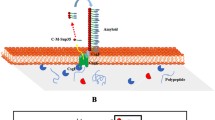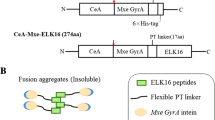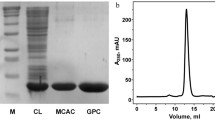Abstract
Antimicrobial peptides (AMPs) are widely expressed and play an important role in innate immune defense against infectious agents such as bacteria, viruses, fungi, and parasites. Cecropins are a family of AMPs synthesized in the fat body of insects that have proven effective at killing specific pathogens. In order to fulfill their clinical potential as antimicrobial drugs, a simple, cost-effective method to express AMPs is sorely needed. In this study, we expressed and characterized the cecropin from Plutella xylostella (pxCECA1) using an intein-dependent expression system in Escherichia coli. We cloned the pxCECA1 gene from larva by RT-PCR and fused the encoding sequence of mature pxCECA1 with an intein gene and a chitin-binding domain gene (CBD) in pTWIN1 plasmid. The fusion protein CBD–intein–pxCECA1 was expressed in E. coli BL21 (DE3) and separated by flowing cell extracts through a chitin column. Subsequently, self-cleavage of the intein at its C-terminus was induced in a temperature- and pH-dependent manner, resulting in the release of mature pxCECA1. The optimal conditions for self-cleavage were determined to be pH 6.0 for 48 h at 4°C, under which 12.3 mg of recombinant pxCECA1 could be recovered from 1 l of E. coli culture. The purified pxCECA1 displayed antimicrobial activity against a broad variety of gram-positive and gram-negative bacteria. This preparation was especially effective against Staphylococcus aureus, including methicillin-resistant strains. Catalase release assays demonstrated that pxCECA1 acts as a microbicidal agent. These results show for the first time that the IMPACT-TWIN expression system is an efficient, cost-effective way to produce fully functional AMPs and that the AMP pxCECA1 is a novel microbicidal agent with promising therapeutic applications.








Similar content being viewed by others
References
Albiol Matanic VC, Castilla V (2004) Antiviral activity of antimicrobial cationic peptides against Junin virus and herpes simplex virus. Int J Antimicrob Agents 23:382–389
Barandoc KP, Kim J, Kim Y (2010) Cotesia plutellae bracovirus suppresses expression of an antimicrobial peptide, cecropin, in the diamondback moth, Plutella xylostella, challenged by bacteria. J Microbiol 48:117–123
Chen X, Zhu FM, Cao YH, Qiao SY (2009) Novel expression vector for secretion of cecropin AD in bacillus subtilis with enhanced antimicrobial activity. Antimicrob Agents Chemother 53:3683–3689
Chernysh S, Kim SI, Bekker G, Pleskach VA, Filatova NA, Anikin VB, Platonov VG, Bulet P (2002) Antiviral and antitumor peptides from insects. Proc Natl Acad Sci U S A 99:12628–12632
Esipov RS, Stepanenko VN, Chupova LA, Boyarskikh UA, Filipenko ML, Miroshnikov AI (2008) Production of recombinant human epidermal growth factor using Ssp dnaB mini-intein system. Protein Expr Purif 61:1–6
Eum JH, Seo YR, Yoe SM, Kang SW, Han SS (2007) Analysis of the immune-inducible genes of Plutella xylostella using expressed sequence tags and cDNA microarray. Dev Comp Immunol 31:1107–1120
Halevy R, Rozek A, Kolusheva S, Hancock RE, Jelinek R (2003) Membrane binding and permeation by indolicidin analogs studied by a biomimetic lipid/polydiacetylene vesicle assay. Peptides 24:1753–1761
Hancock RE, Chapple DS (1999) Peptide antibiotics. Antimicrob Agents Chemother 43:1317–1323
Hancock RE, Lehrer R (1998) Cationic peptides: a new source of antibiotics. Trends Biotechnol 16:82–88
Hancock RE, Sahl HG (2006) Antimicrobial and host-defense peptides as new anti-infective therapeutic strategies. Nat Biotechnol 24:1551–1557
Hultmark D, Steiner H, Rasmuson T, Boman HG (1980) Insect immunity: purification and properties of three inducible bactericidal proteins from hemolymph of immunized pupa of Hyalophora cecropina. Eur J Biochem 106:7–16
Hultmark D, Engström A, Bennich H, Kapur R, Boman HG (1982) Insect immunity: isolation and structure of cecropin D and four minor antibacterial components from cecropia pupae. Eur J Biochem 127:207–217
Humphries HE, Christodoulides M, Heckels JE (2002) Expression of the class 1 outer-membrane protein of Neisseria meningitidis in E. coli and purification using a self-cleavable affinity tag. Protein Expr Purif 26:243–248
Humphries HE, Williams JN, Christodoulides M, Heckels JE (2004) Recombinant meningococcal PorA protein, expressed using a vector system with potential for human vaccination, induces a bactericidal immune response. Vaccine 22:1564–1569
Jin FL, Xu XX, Zhang WQ, Gu DX (2006) Expression and characterization of a housefly cecropin gene in the methylotrophic yeast, Pichia pastoris. Protein Expr Purif 49:39–46
Kato Y, Taniai K, Hirochika H, Yamakawa M (1993) Expression and characterization of cDNAs for Cecropin B, and antibacterial protein of the silkworm, Bombyx mori. Insect Biochem Molec 23:285–290
Kim SR, Hong MY, Park SW, Choi KH, Yun EY, Goo TW, Kang SW, Suh HJ, Kim I, Hwang JS (2010) Characterization and cDNA cloning of a cecropin-like antimicrobial peptide, papiliocin, from the swallowtail butterfly, Papilio xuthus. Mol Cells 29:419–423
Kulkarni MM, McMaster WR, Kamysz W, McGwire BS (2009) Antimicrobial peptide-induced apoptotic death of Leishmania results from calcium-dependent, caspase-independent mitochondrial toxicity. J Biol Chem 284:15496–15504
Lai Y, Gallo RL (2009) AMPed up immunity: how antimicrobial peptides have multiple roles in immune defense. Trends Immunol 30:131–141
Lidholm DA, Gumundsson GH, Xanthopoulos KG, Boman HG (1987) Insect immunity: cDNA clones coding for the precursor forms of cecropins A and D, antibacterial proteins from Hyalophora cecropia. FEBS Lett 226:8–12
Lu XM, Jin XB, Zhu JY, Mei HF, Ma Y, Chu FJ, Wang Y, Li XB (2010) Expression of the antimicrobial peptide cecropin fused with human lysozyme in Escherichia coli. Appl Microbiol Biotechnol 87:2169–2176
Mathys S, Evans TC, Chute IC, Wu H, Chong S, Benner J, Liu XQ, Xu MQ (1999) Characterization of a self-splicing mini-intein and its conversion into autocatalytic N- and C-terminal cleavage elements: facile production of protein building blocks for protein ligation. Gene 231:1–13
Morishima I, Suginaka S, Ueno T, Hirano H (1990) Isolation and structure of cecropins, inducible antibacterial peptides, from the silkworm, Bombyx mori. Comp Biochem Phys B 95:551–554
Papo N, Shai Y (2003) Can we predict biological activity of antimicrobial peptides from their interactions with model phospholipid membranes? Peptides 24:1693–1703
Powers JP, Hancock RE (2003) The relationship between peptide structure and antibacterial activity. Peptides 24:1681–1691
Ueno S, Kusaka K, Tamada Y, Zhang H, Minaba M, Kato Y (2010) An enhancer peptide for membrane-disrupting antimicrobial peptides. BMC Microbiol 10:46
Wang L, Li ZF, Du C, Chen WC, Pang Y (2007) Characterization and expression of a cecropin-like gene from Helicoverpa armigera. Comp Biochem Phys B 148:417–425
Xu XX, Jin FL, Yu XQ, Ji SX, Wang J, Cheng HX, Wang C, Zhang WQ (2007) Expression and purification of a recombinant antibacterial peptide, cecropin, from Escherichia coli. Protein Expr Purif 53:293–301
Yoe SM, Kang CS, Han SS, Bang IS (2006) Characterization and cDNA cloning of hinnavin II, a cecropin family antibacterial peptide from the cabbage butterfly, Artogeia rapae. Comp Biochem Phys B 144:199–205
Zaiou M (2007) Multifunctional antimicrobial peptides: therapeutic targets in several human diseases. J Mol Med (Berl) 85:317–329
Zhao CQ, Liaw LL, Lee IH, Lehrer RI (1997) cDNA cloning of three cecropin-like antimicrobial peptides (Styelins) from the tunicate, Styela clava. FEBS Lett 412:144–148
Zhao ZH, Ma YB, Dai C, Zhao RM, Li SR, Wu YL, Cao ZJ, Li WX (2009) Imcroporin, a new cationic antimicrobial peptide from the venom of the scorpion Isometrus maculates. Antimicrob Agents Chemother 23:3472–3477
Author information
Authors and Affiliations
Corresponding author
Rights and permissions
About this article
Cite this article
Wang, H., Meng, Xl., Xu, Jp. et al. Production, purification, and characterization of the cecropin from Plutella xylostella, pxCECA1, using an intein-induced self-cleavable system in Escherichia coli . Appl Microbiol Biotechnol 94, 1031–1039 (2012). https://doi.org/10.1007/s00253-011-3863-5
Received:
Revised:
Accepted:
Published:
Issue Date:
DOI: https://doi.org/10.1007/s00253-011-3863-5




